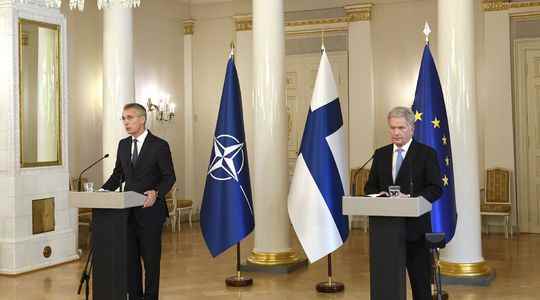“Smooth”. These are the words of NATO Secretary General Jens Stoltenberg, this Thursday, calling for Finland’s accession to the transatlantic treaty. Traditionally attached to a principle of military neutrality and non-alignment, the country has seen its convictions shaken by the war in Ukraine. Bordering Russia, the nation fears an externalization of the conflict in Ukraine, after the invasion launched by the Russian army at the end of February.
Being neither a signatory of NATO nor a member of the European Union, Ukraine was confronted from the first days of the war with the American and European refusal to provide it with direct military aid. While many Western countries have delivered arms to the country led by Volodymyr Zelensky, the Ukrainian resistance cannot enjoy the support of an ally’s special forces. This horizon, feared by the Finnish power, pushed it, this Thursday, to take a clear and public position in favor of rallying to NATO. President Sauli Niinistö and Prime Minister Sanna Marin said they were in favor of joining the Nordic country “without delay”. Neighboring Sweden is also expected to announce its decision in the next few days.
- How long does it take to join NATO?
The procedure to join the military alliance is cumbersome and tedious. Volodymyr Zelensky was sorry about this in March during a videoconference with a British military coalition. “We heard for years that the doors were open, but we also heard that we couldn’t join. That’s the truth,” he resigned himself. Jens Stoltenberg skirted the criticism in the Finnish case: “If Finland decided to apply, it would be warmly welcomed into NATO and the accession process would go quickly.”
If it is impossible to define precisely the duration to integrate NATO, membership can take several years. Invited since 2010 by the members of the alliance, Bosnia and Herzegovina is continuing its work to bring it into compliance with the political, legal and military obligations and commitments resulting from the Washington Treaty.
- Which membership procedure in NATO?
To be a member of NATO, three major criteria must be met: being a European country, respecting democratic principles and contributing to the security of the Euro-Atlantic area. If these States fulfill them and especially if they publicly express the wish to join the alliance, as Finland did, they can be invited by the member countries. This invitation can only be made unanimously. Membership talks then began. Here, if the invitation is extended to Finland, then the country will have to comply with a number of requirements that meet the policy of the organization. Finally, once the reforms carried out by the aspirants in their defense systems, a last crucial stage points out: the popular adhesion. The invited state must pass its own law ratifying the North Atlantic Treaty, either by holding a referendum or presenting it to parliament.
This shuttle requires general support for the project. In Finland, 76% of the 5.5 million inhabitants are now in favor of membership, according to a poll published on Monday, triple its pre-war level. A very large majority of the 200 deputies is now in favor of a rallying. This explains the swing made by the country, which until then did not see membership in a good light. Public opinion appears to be ready to embark on a similar shift in Sweden: a majority of 54% of Swedes would now be in favor of NATO membership, according to a poll by the Novus institute published recently.
NATO is not the only organization to which a country, in this time of war, aspires to join. This Thursday, Dmytro Kouleba, the head of Ukrainian diplomacy, asked that a place be “reserved” for his country in the EU. This statement follows numerous similar outings by Volodymyr Zelensky on the subject.
Integration into the European Union is governed by Article 49 of the Treaty on Organisation. It provides that any European country “respecting the fundamental principles” of the union can apply for membership. Its candidacy is regularly preceded by an “association agreement”, which sets up a free trade area with the EU. A first step towards the gradual entry of community rules into national law, a condition for integrating the Union. Like the period of upgrading of an aspiring state in NATO, the European Union offers to participate in European programs and by granting it financial aid and thus conduct a pre-membership policy. Then open accession negotiations which aim to verify the compatibility between the Member State and Europe. They last for several years.
